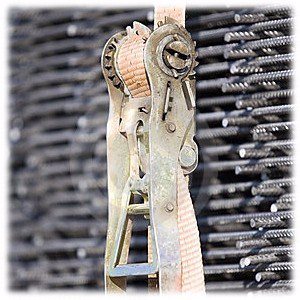Safety: Securing Your Cargo
Posted on in General by Admin
 If you’ve ever traveled behind a log truck, chances are you’ve hoped the person who loaded that truck had safety in mind. According to a 3-year study by the AAA foundation, there were 500 fatalities due to unsecured loads.
If you’ve ever traveled behind a log truck, chances are you’ve hoped the person who loaded that truck had safety in mind. According to a 3-year study by the AAA foundation, there were 500 fatalities due to unsecured loads.Securing a load properly—meaning that it’s essentially immobile while in transit—is crucial to the safety of everyone sharing the road with you—and it also ensures you don’t lose or damage the products that you are hauling. You do not want to take any risks because a poorly secured load can mean loss of product, loss of money and, in the worst-case scenario, loss of life.
Ratchet straps are commonly used to secure loads to trailers or truck beds, but what are some other tie-down methods? Here, we’ll share some alternatives with you, but bear in mind that you must consider the weight you’re carrying, your anchors and the cargo’s arrangement when selecting the safest option.
Chains – A viable option for larger, heavy items, such as an ATV, another car, a motorcycle, boat or other heavy-duty machinery.
Cargo Nets – Most often made of rope, work well for light items on a secure trailer. You might have seen a cargo net on a team-building obstacle course, too!
Rope – Knots best-suited for cargo include alpine butterfly, bowline and double half-hitch. Be sure your rope is about a quarter-inch thick and plan to have 100 feet or more on hand to secure your load. If you’re reusing rope, be sure it’s not frayed. The downside to using rope, though, is that it’s not rated for a specific weight, so it’s difficult to know for sure if it will hold.
Bungee cords – While not usually recommended for securing cargo, these elastic cords can help in a pinch for smaller, lighter items. Like rope, bungees aren’t usually rated for weight.
No matter what tie-down method you use, make sure you test it! Don’t just eyeball it: rock your load, tug at the restraints. Otherwise, once you start moving, your load could go sailing! After 10 minutes of driving, check again, as loads can shift in transit.
